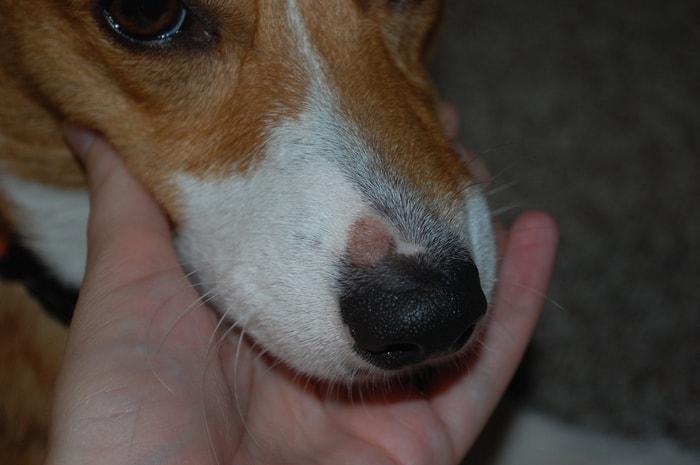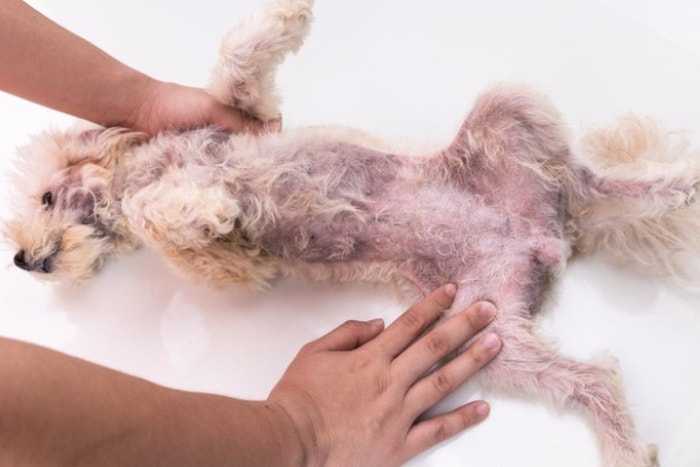Aspergillosis in dogs or Fungal Rhinitis is an infection that involves the nose and sinuses. Aspergillus fumigatus is a ubiquitous saprophytic fungus capable of colonizing the nasal cavity and frontal sinuses. Rarely, disseminated Aspergillosis can develop in dogs. This unusual condition is most likely to occur in immunosuppressed dogs. However, nasal Aspergillosis is most likely to occur in dogs without the concomitant disease.
Important Information on Aspergillosis in Dogs
Aspergillosis is one of the most common fungal diseases of dogs. The fungus is most commonly found as a lacy mold that grows on foods.A. fumigatus infection is associated with the production of a dermonecrotic endotoxin that is presumed to cause turbinate necrosis and erosion of the planum nasale. The infection is found worldwide, and it is primarily a respiratory infection.

Causes of the Fungal Rhinitis in Dogs
Aspergillosis in dogs is caused by some species of fungus of the genus Aspergillus. A fumigatus is the most common implicated species in Aspergillosis, grows abundantly in rotting vegetation and wood chips, compost, sewage, and moldy hay.

What are the Symptoms of Aspergillosis in Dogs?
Nasal Aspergillosis is most likely to occur in dogs of three years of age or younger, although dogs of all ages may be affected. The three clinical hallmarks of infection are- chronic, profuse, and sanguinopurulent nasal discharge—ulceration of the external nares; nasal or facial pain.
- Profuse nasal discharge.
- Nasal pain.
- Ulceration of the external nares.
- Sanguinopurulent discharge.
- Frontal sinus infection.
- Epistaxis or nose bleeding.
- Mucopurulent discharge.
- Sparse nasal discharge.
- Sneezing.
- Discomfort on palpation of the nose.
How to Diagnose Aspergillosis in Dogs?
Your experts or veterinarian performs the diagnosis. Clinical signs make the presumptive diagnosis, and confirmatory diagnosis is based on radiology. Your vets analyzed the clinical signs and history and recommended different types of test that helps the confirmatory diagnosis.
Radiology:
- A dorsoventral image of the nasal chamber is made using a piece of non-screen film inside the dog’s mouth
- Radiographic evaluation of the nasal cavity
- Turbinate destruction with an overall increase in radiolucency
Rhinoscopy:
Fungal colonies appear as greenish-white plaques.
Mycology
Fungal hyphae can be demonstrated by either direct culture of plaques, cytological examination of discharge, or histopathological evaluation of turbinate tissue.
Serology
Enzyme-linked immunosorbent assays (ELISA).
Agar gel immunodiffusion (AGID) tests.
Differential diagnosis of Aspergillosis
Nasal Aspergillosis is difficult to confirm in clinical practice. Several intranasal disorders such as foreign body, oronasal fistula, and neoplasia should be ruled out. Bacterial rhinitis is a common secondary manifestation of intranasal disease, regardless of the cause, and should not be considered a primary disorder.
Treatment for Aspergillosis in Dogs
- The systemic therapy of nasal Aspergillosis has been the principal treatment for several years. Your vets recommended Itraconazole or fluconazole.
- Topical econazole or topical clotrimazole will cure most cases.
- Your experts perform the surgery, and surgery is used solely to insert tubes into the frontal sinuses and nasal chambers for drug irrigation.
- Dogs with extranasal soft tissue involvement should receive a combination of both topical and systemic therapy.
- The best indication of treatment success is the resolution of sanguineous discharge, nasal pain, and ulceration.
Prevention and Control of Aspergillosis in Dogs
There is no vaccine presently available for use in companion animals to prevent Aspergillosis. Since the organism is a ubiquitous fungus, it is clinically impractical to advise you on avoiding pets having contact with the organism.